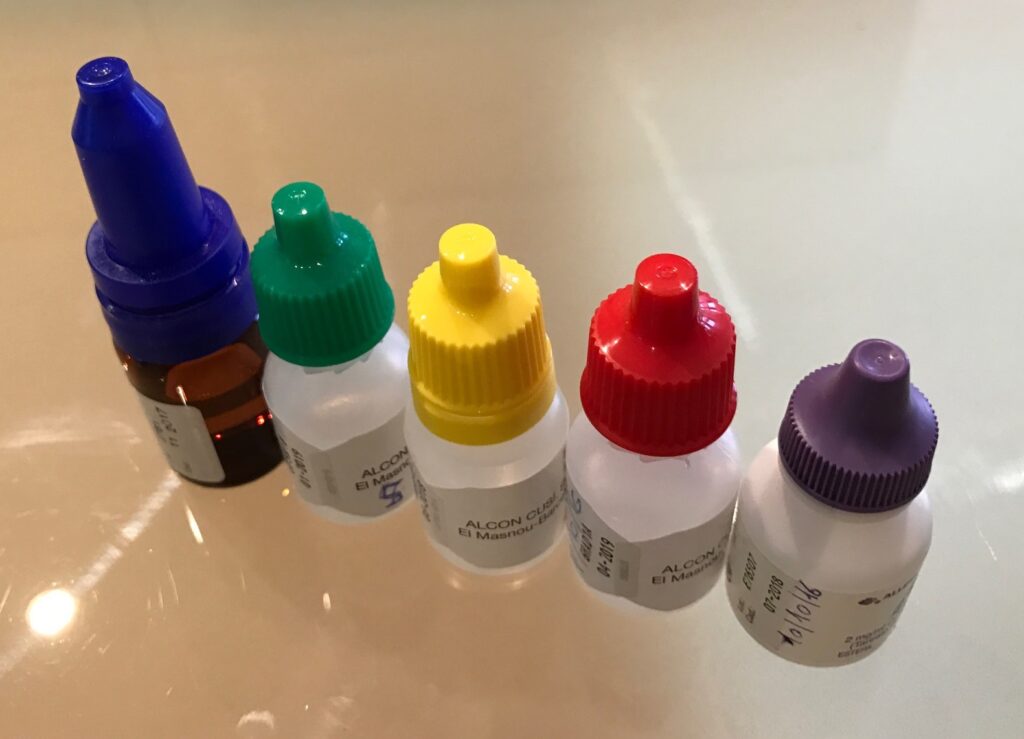
Not all eye drops are alike
Eye drops are pharmaceutical preparations consisting of sterile solutions or suspensions of one or more substances, intended to be applied (instilled) into the eye.
Doctor, I used eye drops. Many patients report during consultation that they have used eye drops, but which ones? Which eye drops are they referring to? They think that there is only one universal drug that is applied to the eye, and it is called eye drops.
First of all, it is important to know that an eye drop is a liquid drug in a bottle that allows it to fall into the eye in dosed drops. Therefore, the first thing to know is that eye drops are a way of administering drugs, so there are different types of eye drops. In other words, eye drops are like pills in the mouth. No one ever tells the doctor that they have taken some pills; we tell them which pill exactly we have taken or, if we cannot remember the name of the pill, what it was for.
Types of eye drops
Existen diversos tipos de colirios donde los más destacados serían lágrimas artificiales, antiinfecciosos, antiinflamatorios, antihistamínicos (para la alergia), o para enfermedades propias del ojo como el glaucoma o el queratocono.
There are different types of eye drops, the most important of which are artificial tears, anti-infectives, anti-inflammatories, antihistamines (for allergies) or for eye diseases, such as glaucoma or keratoconus.
As a side note, the caps on the eye drop containers in ophthalmology centres are colour-coded to identify the type of drug they contain. Below are the three main categories:
- Red: for drops that dilate the pupil.
- Green: for drops that constrict the pupil.
- Yellow: for anaesthetic drops.
For other kinds of eye drops, identification is not so important, hence the colours may vary.
Once the eye drop container has been opened, sterility is lost, so it is necessary for the drug to come with a series of preservatives that keep the solution sterile for as long as possible. This is achieved by using substances with a broad microbial spectrum that do not irritate the ocular mucous membrane and do not react with the active ingredient (medicine). In view of this difficulty, eye drops are increasingly being used in single-dose containers, which not only ensure sterility, but also make the use of preservatives unnecessary.
Además, la viscosidad es la propiedad que describe la adherencia del producto al ojo. Esto favorece el contacto del principio activo con la mucosa conjuntival, y, por tanto, su eficacia. Para conseguir la máxima viscosidad sin afectar la estabilidad del colirio ni ser irritante, se añaden diferentes sustancias inertes del tipo metilcelulosa.
Furthermore, viscosity is the property that describes the product’s adhesion to the eye. This enhances the contact of the active ingredient and the conjunctival mucosa and, therefore, its effectiveness. To achieve maximum viscosity without affecting the stability of eye drops or being irritating, different inert substances, such as methylcellulose, are added.
How are eye drops applied?
Eye drops should be handled with clean washed hands before applying these ophthalmic liquids to avoid infections. To avoid contaminating the medication, it is important that the tip of the container containing the preparation does not come into contact with any surface at any time (including the eye). To easily apply these drugs, it is advisable to tilt your head back to facilitate the application, lower the lower eyelid with your fingers and introduce the eye drops into the ensuing cavity (in the so-called fundus of the conjunctival sac), never above the centre of the eye.
Try to apply the exact number of drops prescribed and then try to blink a couple of times to spread the drops over the entire eye surface. Then close your eyes for a few minutes to wipe away any excess liquid that may spill out. If you need to apply a second eye drop, it is better to wait a few minutes so that the first eye drop can be properly absorbed.
What precautions should I take? It is important to bear in mind that the eye drops should not be shared between patients, as they are for personal use only, and the container must be kept properly closed in a cool, dry place. Thanks to all these precautions, we will achieve ideal conditions for the drug to fully develop the action we expect.
Adverse effects
Like other drugs, eye drops can sometimes have adverse effects when instilled, such as a burning sensation, blurred vision or sticky eyelids. If you experience any discomfort when using eye drops, you should stop using them and tell your ophthalmologist which eye drops you are using.
Recommendations for using eye drops
Contact lenses should not be used when applying eye drops. This is because the drug substances and preservatives in eye drops can build up on contact lenses and affect them. Sometimes you may notice the taste of the eye drops in your mouth or throat. This can happen and is normal, because the tear duct drains into the nasal passage, which in turn is connected to the throat. In such cases, you can press the inner corner of the eye (over the nose and lower eyelid) and below the lower tear duct with a finger for a couple of minutes after instilling the eye drops.
Ophthalmic preparations are no longer sterile once opened, hence they should not be stored when the treatment ends.
Vision may become blurred for a few moments, so activities requiring good visual acuity should be avoided during this time.